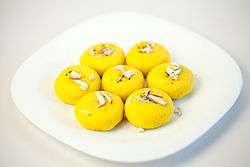Peda
- Not to be confused with Petha.
 | |
| Alternative names | Pedha, Pera |
|---|---|
| Course | Dessert, Prasad |
| Place of origin | Indian subcontinent (Mathura, Uttar Pradesh, India) |
| Region or state | Indian subcontinent, Mauritius, Fiji, southern and eastern Africa, the Caribbean, the Malay Peninsula |
| Main ingredients | Khoya, sugar |
Peda (pronounced [ˈpeːɽaː]) or Pera is a sweet from the Indian subcontinent, usually prepared in thick, semi-soft pieces. The main ingredients are khoa, sugar and traditional flavorings, including cardamom seeds, pistachio nuts and saffron. The colour varies from a creamy white to a caramel colour. The word peda is also generically used to mean a sphere of any doughy substance, such as flour or khoa. Variant spellings and names for the dessert include pedha, penda (in Gujarati) and pera.
Pendas originated in the city of Mathura in present-day Uttar Pradesh.[1] The Mathura Peda is the characteristic variety from the city. From Uttar Pradesh, the peda spread to many parts of the Indian subcontinent. Thakur Ram Ratan Singh of Lucknow, who migrated to Dharwad (in present-day Karnataka) in the 1850s, introduced pedas there. This distinct variety is now famous as the Dharwad pedha.[2][3] Kandi Peda from Satara in Maharashtra is another variety of peda.[4]
As with laddoos, pedas are sometimes used as prasadam in religious services.
 Kesar Peda with Garnishing of Pistachio and Cardamom
Kesar Peda with Garnishing of Pistachio and Cardamom
References
- ↑ Sanjeev Kapoor. Mithai. Popular. ISBN 9788179917121.
- ↑ "Pedas, anyone?". Deccan Herald. 13 May 2008. Retrieved 2008-10-16.
- ↑ Ashwin Rajagopalan (26 January 2016). Dharwad Peda: A Regional Favourite From Karnataka's Sweet Repertoire, NDTV.
- ↑ 13 products have potential for GI registration